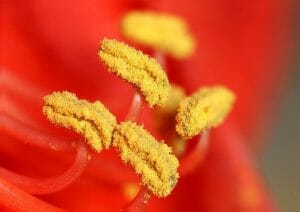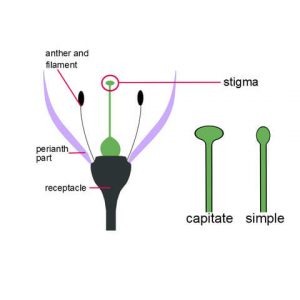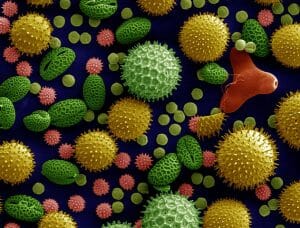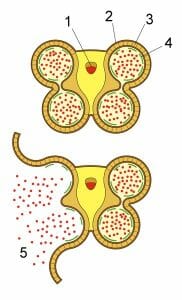Pollen Definition
Pollen refers to the powdery product synthesized by seed plants responsible for the production of the male gametes of the plant (shown below).
The pollen grains are termed microgameteophytes, and consist of a sporopollenin coating which serves to protect the gameteophytes as they are transported from the stamens (male) or male cone to the pistil (female) or female cone in flowering and coniferous plants, respectively. When the pollen reaches the pistil or female cone, a pollen tube is formed, which transports the sperm to the ovule containing the female gametophyte. The term pollination refers to the transfer of pollen grains from the anther to the stigma of a flower. Cross-pollination involves the transfer of pollen from one flower to the stigma of another flower. In contrast, self-pollination involves the transfer of pollen from one flower to the stigma of the same flower. A diagram illustrating the location of the anther and stigma is shown below.
Pollen Structure
Pollen grains vary in size, shape, and surface characteristics depending on the plant species (shown below). In general, pollen grains have a double wall consisting of a thin inner wall composed of cellulose, termed the endospore, and a thick outer wall comprised of sporopollenin, termed the exospore. The shape and the external features of the exospore are highly variable, and are often used to distinguish pollen grain produced by different species. The purpose of this structure is to protect the male genetic material from the environment (e.g., UV radiation, compression, and water) during the transportation from the anther to the stigma. The surface of the pollen grain also contains various waxes and proteins which help repel moisture and interact with the stigma, respectively. However, such protein structures on the surface of pollen are often recognized by immune cells and are the source of the allergic reactions to pollen observed in humans.
Pollen Formation
In coniferous plants, pollen is formed in the microsporangia of the male cone, whereas it is produced in the anthers of flowering plants (also termed angiosperms). Each microsporocyte is diploid and forms four haploid cells, termed microspores, via meiosis. This process is termed microsporogenesis. The four microspores then form the double wall of the pollen grain within a structure made of callose. During this process, the callose is digested by callase and the pollen grains are able to grow and complete the formation of the endospore and exospore. The diagram below illustrates the release of pollen grains from the callose structures.
Quiz
1. The transfer of pollen from the anther to the stigma of a flower is termed:
A. Endoporation
B. Germination
C. Pollination
D. Microsporogenesis
2. The primary function of the exospore is:
A. Pollination
B. Protect the plant’s male genetic material
C. Protect the plant’s female genetic material
D. Endoporation
References
- Clarke A, Gleeson P, Harrison S, and Knox B. (1979). Cell Biology Pollen-stigma interactions: Identification and characterization of surface components with recognition potential. Proc. Nati. Acad. Sci.76(7):3358-3362.




